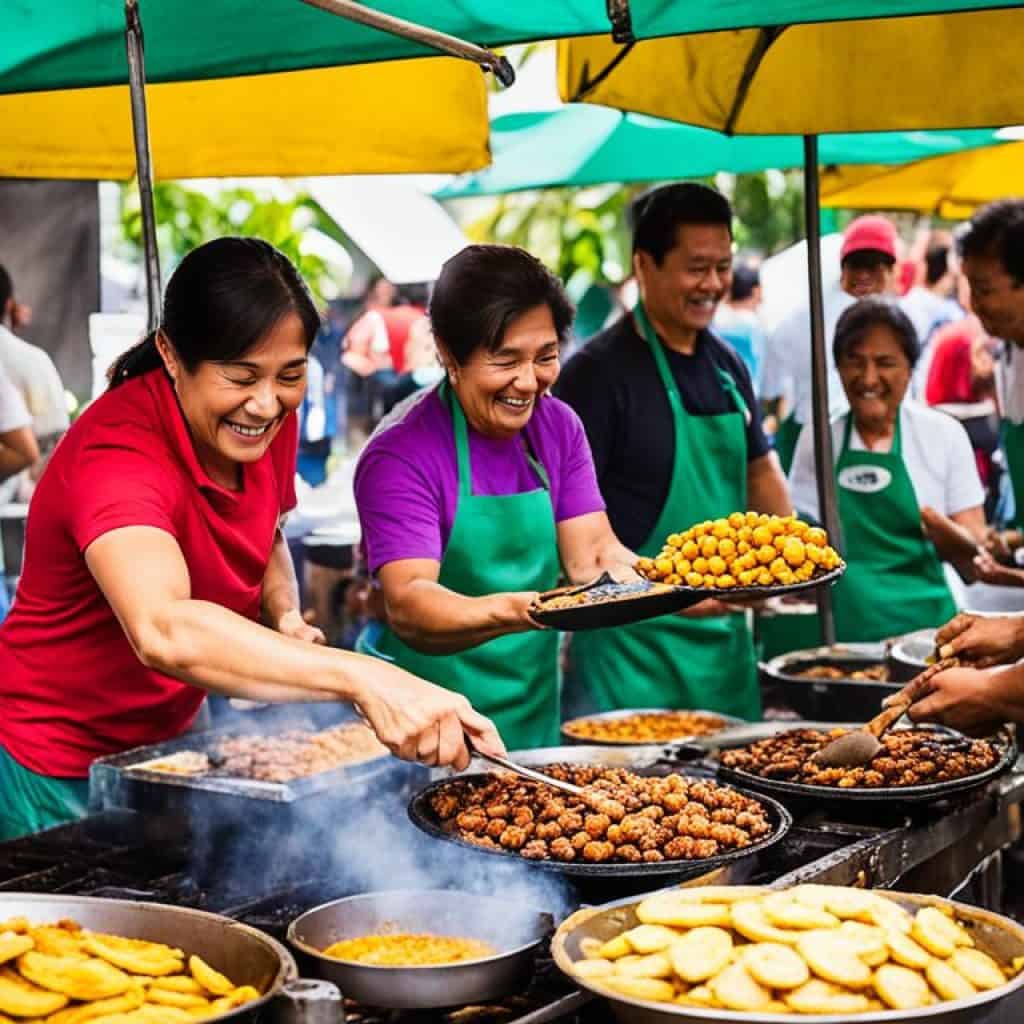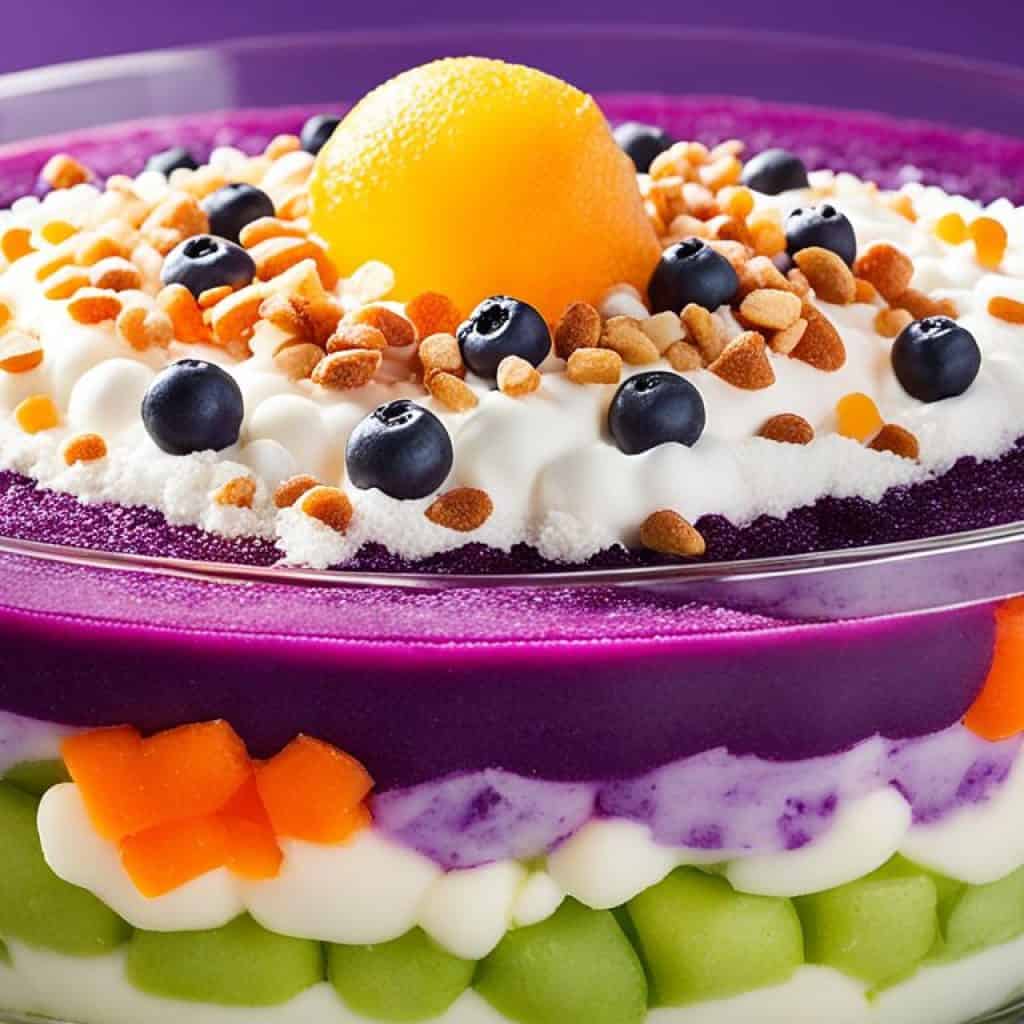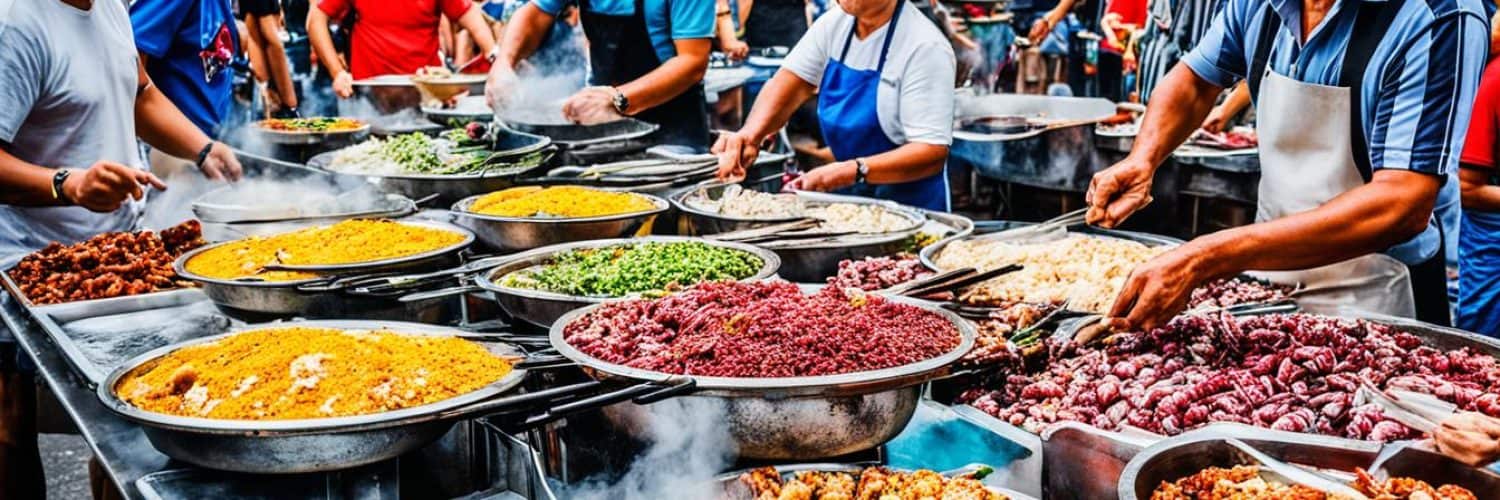Are you ready to embark on a culinary adventure that will tantalize your taste buds and leave you craving for more? Look no further than the vibrant and diverse world of Filipino street food. From the bustling streets of Manila to the local markets in the provinces, the Philippines offers a treasure trove of delectable street food delights to satisfy your cravings.
But what makes Filipino street food so special? Is it the unique flavors, the mouthwatering aromas, or the rich cultural heritage that each bite represents? Join us as we dive into the fascinating world of Filipino street foods and uncover the secrets behind these tantalizing treats.
Key Takeaways:
- Filipino street food is a vibrant and diverse culinary experience that reflects the rich culture and flavors of the Philippines.
- From the infamous balut to the crispy Banana Q, there is a wide range of street food delights to discover in the bustling streets of Manila and beyond.
- Exploring Filipino street food is a must for any food lover, as it offers a unique blend of flavors and experiences that will leave you wanting more.
- Whether you’re a fan of adventurous eats or nostalgic snacks, the street food scene in the Philippines has something to satisfy everyone’s cravings.
- So, get ready to explore the best street foods in the Philippines and embark on a culinary journey like no other.
Balut – The Infamous Filipino Delicacy
Balut is one of the most infamous Filipino street foods, known for its unique and adventurous nature. Considered a delicacy, balut is a fertilized duck or chicken egg that is incubated for 14-21 days, boiled, and then enjoyed directly from its shell. This Filipino street food is a culinary experience like no other, offering a combination of flavors, textures, and even visual surprises.
When you crack open the shell of balut, you will discover a partially developed embryo inside. The embryo can range from being soft and unrecognizable to having recognizable features like feathers or beaks, depending on the incubation period. The distinct aroma and taste of balut, accompanied by a sprinkle of salt and a dash of vinegar, create a uniquely satisfying experience for those willing to give it a try.
The combination of flavors and textures is what makes balut a must-try street food for adventurous eaters. The creamy yolk, savory broth, and tender yet slightly chewy embryo offer a multisensory delight that is both intriguing and delicious. Despite its unusual appearance, balut has become an iconic Filipino delicacy that is cherished by locals and sought after by curious food enthusiasts from around the world.
Indulge in the exotic flavors of balut and experience the rich culinary heritage of the Philippines. With every bite, you’ll embark on a unique gastronomic adventure that will leave a lasting impression.
Whether you’re a seasoned foodie or someone looking to expand their culinary horizons, balut is a street food that should not be missed. It represents the bold and adventurous spirit of Filipino cuisine, making it an essential part of any street food exploration in the Philippines.
Not for the Faint of Heart
While balut may be considered unusual or even intimidating to some, it is worth stepping out of your comfort zone to try this one-of-a-kind delicacy. The taste and experience of balut can be surprising, but it is a testament to the diverse flavors and cultural richness found in Filipino street food.
So, the next time you find yourself in the Philippines, don’t miss the opportunity to indulge in balut, the infamous Filipino delicacy. It’s a food adventure that will satisfy your curiosity and offer a truly unforgettable culinary experience.
Banana Q / Kamote Q – Crispy Sweet Plantain Delights
Indulge your taste buds with the delightful flavors of Banana Q and Kamote Q, two popular Filipino street foods that bring a crispy and sweet twist to your snacking experience.
Banana Q, also known as Banana Cue, is a beloved street food made from ripe plantains. These sweet and starchy fruits are skewered, deep-fried to perfection, and coated in caramelized brown sugar. The result is a tantalizing combination of crispy exteriors and soft, succulent interiors that will leave you craving for more. With each bite, the rich sweetness of the caramelized sugar blends harmoniously with the natural sweetness of the plantains, creating a symphony of flavors that is truly irresistible.
Kamote Q, on the other hand, offers a delightful variation using sweet potatoes instead of bananas. The sweet potatoes are prepared in the same manner, resulting in a similar crispy texture and caramelized sweetness. Kamote Q provides a unique twist to the classic Filipino street food experience, offering a satisfying alternative for those who prefer a slightly earthier flavor profile.
Both Banana Q and Kamote Q are popular choices for merienda, the traditional midday snack time in the Philippines. These delicious treats evoke nostalgia and childhood memories for many Filipinos, reminding them of carefree afternoons spent indulging in these crispy delights. Whether enjoyed on their own or paired with a cup of hot chocolate or a refreshing glass of sago’t gulaman, Banana Q and Kamote Q are sure to satisfy your cravings and transport you to the vibrant streets of the Philippines.

Experience the crispy and sweet magic of Banana Q and Kamote Q, and let their flavors transport you to the bustling streets of the Philippines. Don’t miss out on these iconic Filipino street foods that showcase the rich culinary heritage of the country.
Buko – The Refreshing Filipino Coconut Treat
Buko, which means young coconut in Tagalog, is a refreshing and popular Filipino street food. It is commonly sold in wooden pushcarts by street vendors who skillfully hack open the coconuts right in front of their customers. The sight of the glistening coconut water and the promise of sweet, tender coconut meat make it an irresistible treat for locals and tourists alike.
One of the joys of indulging in buko is the ability to drink the coconut water directly from the coconut itself. With a straw inserted into the soft flesh of the coconut, you can revel in the pure, hydrating liquid goodness that the buko has to offer. It’s a simple pleasure that provides instant refreshment on a hot, tropical day.
But the enjoyment of buko doesn’t stop there. The coconut meat, scooped out from its shell, can be savored as is or further enhanced with a delectable addition – condensed milk. The natural sweetness and creamy texture of the coconut meat perfectly complement the smooth, indulgent taste of condensed milk, creating a heavenly fusion of flavors.
Not only is buko a delicious treat, but it also boasts several health benefits. The coconut water is rich in electrolytes, making it an excellent source of hydration. It is also known to help regulate blood pressure and improve digestion. As for the coconut meat, it is packed with essential nutrients, including dietary fiber, healthy fats, and vitamins.
Health Benefits of Buko:
- Promotes hydration
- Regulates blood pressure
- Improves digestion
- Rich in essential nutrients
So, the next time you find yourself wandering the bustling streets of the Philippines, keep an eye out for the tantalizing sight of buko being sold in all its glory. Experience the refreshing taste and healthful benefits of this beloved Filipino street food. It’s a true tropical delight that will transport you to the sunny shores of the Philippines with every sip and bite.
| Buko | Health Benefits |
|---|---|
| Refreshing and delicious street food | Promotes hydration |
| Sold in wooden pushcarts | Regulates blood pressure |
| Enjoy the coconut water and meat | Improves digestion |
| Option to mix with condensed milk | Rich in essential nutrients |
Indulge in the delightful taste of buko along the vibrant streets of the Philippines, and embark on a culinary journey that celebrates the tropical flavors and healthful benefits of this beloved Filipino street food.
Bulaklak – The Unique Grilled Offal Dish
When it comes to Filipino street food, bulaklak is a standout delicacy that offers a unique culinary experience. Also known as chicharon bulaklak, this street food specialty is made from pork chitterlings or mesentery, creating a dish that is both crispy and flavorful.
Traditionally, bulaklak is deep-fried to achieve a crispy texture that perfectly complements its rich taste. The result is a dish that is satisfyingly crunchy on the outside while offering a melt-in-your-mouth sensation on the inside. Seasoned with a medley of spices and served with a tangy dipping sauce, bulaklak is a hit among food enthusiasts looking to explore the bold flavors of Filipino street cuisine.
While chicharon bulaklak is commonly found in Filipino bars, there is another version of this delightful dish called inihaw na bulaklak, which translates to grilled bulaklak. Inihaw na bulaklak offers a different experience with its smoky flavor profile and lighter texture. It is prepared by grilling the pork chitterlings or mesentery over an open flame, resulting in a mouthwatering dish that offers a healthier alternative to the deep-fried version.
Overall, bulaklak is a unique street food that showcases the versatility and creativity of Filipino cuisine. Whether you prefer the crispy indulgence of chicharon bulaklak or the smoky goodness of inihaw na bulaklak, this dish is a must-try for anyone seeking an authentic Filipino street food experience.
Empanada – The Spanish-inspired Filipino Street Food
Empanada is a delicious and convenient street food that has become a beloved staple in the Philippines. With its Spanish influences, this filled pastry turnover offers a delightful blend of flavors and textures that will satisfy your cravings.
Empanadas are typically made by enclosing a savory filling in a pastry crust, which is then either baked or fried to perfection. The fillings can vary, but common ingredients include ground meat such as beef, pork, or chicken, along with potatoes, onions, carrots, peas, and raisins. This combination creates a harmonious balance of savory and slightly sweet flavors that is simply irresistible.
What makes empanadas even more appealing is their versatility. While the classic empanada is a savory treat, there are also dessert variations that feature sweet fillings like fruits or chocolate. This wide range of options ensures that there is an empanada to suit every taste preference.
Distinctive Variations:
The Philippines is known for its regional delicacies, and empanadas are no exception. One notable variation is the Vigan empanada, which hails from the city of Vigan in Ilocos Sur. This empanada is distinctively orange in color, thanks to the use of achuete or annatto oil in the dough. It is filled with a combination of ground pork, green papaya, egg, and vermicelli noodles, creating a unique and flavorful experience.
Other regions of the Philippines also have their own takes on empanadas, incorporating local ingredients and flavors. For example, in Batangas, their version of empanada called panutsa empanada features a filling made from melted panutsa, a sweet molasses-like syrup derived from sugarcane. These regional variations add to the charm and diversity of empanadas across the country.
To fully appreciate the delectable flavors of empanadas, it is best enjoyed with your choice of sauce or dip. Some popular options include vinegar with garlic, spicy vinegar, or banana ketchup. The tangy and savory notes of these condiments enhance the overall taste experience, making every bite even more satisfying.
| Region | Distinct Variation |
|---|---|
| Vigan, Ilocos Sur | Vigan Empanada |
| Batangas | Panutsa Empanada |
| Various regions | Regional Variations |
Whether you’re exploring the busy streets of Manila or venturing into the provinces, you’re likely to come across empanadas being sold by street food vendors. Their enticing aroma and golden crust make them hard to resist. Empanadas are not only a satisfying snack on the go but also a tasty option for a quick meal.
So, the next time you find yourself craving a delicious and filling treat, give in to the temptation and savor the flavors of empanadas. This Spanish-inspired Filipino street food is a must-try culinary delight that will leave you wanting more.
Fish Balls / Chicken Balls – Iconic Filipino Street Food
Fish balls and chicken balls are iconic Filipino street foods that are loved by many. These balls are made from a mixture of flour and flaked fish or chicken meat, and they are deep-fried to achieve a crispy exterior and a soft interior.
“Fish balls and chicken balls are beloved street food snacks in the Philippines. The crispy texture on the outside paired with the tender meat on the inside creates a delightful contrast of flavors and textures.” – Maria Cruz, a Filipino street food vendor
Fish balls are often served with a sweet and spicy sauce or vinegar for dipping, adding an extra burst of flavor. Whether enjoyed as a quick snack on the go or as part of a larger meal, these affordable and tasty treats are a common sight on the bustling streets of the Philippines.
Both locals and tourists of all ages can be seen relishing these delightful bites, savoring the unique flavors and experiencing the lively atmosphere of Filipino street food culture.
Benefits of Fish Balls and Chicken Balls
Aside from being delicious and satisfying, fish balls and chicken balls offer several benefits:
- High protein content: The flaked fish or chicken meat used in these balls provides a good source of protein, which is essential for muscle growth and repair.
- Easy to eat: These bite-sized balls are convenient to eat while walking or exploring the vibrant streets of the Philippines.
- Affordable: Fish balls and chicken balls are inexpensive street food options, making them accessible to people from all walks of life.
Experience the joy of indulging in these classic Filipino street food favorites and discover why they have become such a beloved part of the local culinary scene.

Stay tuned for the next section, where we will explore another mouthwatering Filipino street food delight!
Ginanggang – Grilled Banana Delight
Ginanggang is a popular Filipino street food that will delight your taste buds with its simplicity and deliciousness. Made from grilled cardava bananas, this delightful snack is a favorite among locals and visitors alike.
The process of making Ginanggang is quite straightforward. The cardava bananas are grilled over charcoal until they become tender and develop a slight caramelization. The heat of the grill brings out the natural sweetness of the bananas, giving them a rich and irresistible flavor.
One of the best things about Ginanggang is its versatility. It can be enjoyed as a quick and satisfying snack, or even as a light meal on its own. The grilled bananas can be eaten as they are, or for an extra touch of indulgence, you can sprinkle some sugar on top or drizzle them with a bit of margarine to further enhance the flavors.
If you ever find yourself in the southern islands of the Philippines, Ginanggang is a street food that you simply cannot miss. Its humble yet delicious nature perfectly captures the essence of Filipino cuisine, and you’ll find vendors selling this delightful treat in bustling markets and along busy streets.
So, why not take a break from the hustle and bustle of your day, and savor the taste of Ginanggang? Whether you’re exploring the vibrant city of Manila or venturing off the beaten path, this grilled banana delight will surely satisfy your cravings for a unique Filipino street food experience.
Halo-Halo – The Ultimate Filipino Dessert
Halo-Halo is a beloved Filipino dessert and street food. It is a colorful and refreshing concoction made with crushed ice, sweetened fruits, jelly, beans, ube (purple yam), and other ingredients. The term “Halo-Halo” means “mix-mix” in Tagalog, and it is aptly named because the dessert is meant to be mixed together before eating. Halo-Halo is a delightful treat that provides a burst of flavors and textures in every spoonful.

Indulging in a bowl of Halo-Halo is like taking a sweet journey through Filipino taste buds. Each layer of this delectable dessert adds a unique element to the overall experience. The crushed ice provides a cool and refreshing base, while the sweetened fruits and jelly bring bursts of fruity flavor. The beans add a creamy and earthy texture, and the vibrant purple yam (ube) contributes a subtly sweet and nutty taste.
Halo-Halo is not only a treat for the taste buds but also a feast for the eyes. Its vibrant colors and artistic presentation make it a visually appealing dessert. As you take your first spoonful, the flavors blend together harmoniously, creating a delightful symphony of tastes and textures.
“Halo-Halo is the perfect dessert for those hot and humid days in the Philippines. Its refreshing and eclectic combination of ingredients is a true representation of Filipino creativity and culinary ingenuity.”
While the traditional Halo-Halo recipe includes common ingredients like sweetened fruits, jelly, beans, and ube, modern variations have emerged, featuring additional toppings such as leche flan (caramel custard), coconut strips, taro balls, and even cheese. The possibilities are endless when it comes to customizing your own Halo-Halo.
Halo-Halo is best enjoyed on a sunny day, whether you’re strolling along the bustling streets of Manila or relaxing by the beach. This iconic Filipino dessert is not only a sweet treat but also a cultural experience that captures the essence of Filipino street food.
So, the next time you find yourself in the Philippines, don’t miss the opportunity to savor a bowl of Halo-Halo. Immerse yourself in its vibrant flavors and discover why it has become the ultimate Filipino dessert and a beloved street food.
Conclusion
Filipino street food is a culinary adventure that takes your taste buds on a journey through the vibrant culture and flavors of the Philippines. From the daring experience of trying balut to the familiar and heartwarming bites of Banana Q and Halo-Halo, exploring the street food scene in the Philippines is a must for any food enthusiast. Whether you’re wandering the bustling streets of Manila or immersing yourself in a local market, the diverse array of street food options will satisfy your cravings and leave you wanting more.
Every bite of Filipino street food tells a story, reflecting the rich culinary heritage of the country. The combination of unique ingredients, bold flavors, and creative preparations result in an unmatched gastronomic experience. Immerse yourself in the world of Filipino street foods and indulge in the mouthwatering delights that make this cuisine so special.
So, grab your tastebuds with excitement and dive into the world of Filipino street food. From the savory and the spicy to the sweet and refreshing, each bite is a celebration of the rich culinary heritage of the Philippines. Discover the hidden gems and iconic snacks that make the street food scene in the Philippines truly unforgettable. Street Foods In The Philippines are waiting to be explored and savored, one delicious bite at a time.


















Add comment